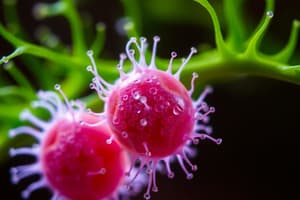Podcast
Questions and Answers
Plants are ______ organisms that produce their own food through photosynthesis.
Plants are ______ organisms that produce their own food through photosynthesis.
autotrophic
Animals are ______ organisms that obtain food by consuming other organisms.
Animals are ______ organisms that obtain food by consuming other organisms.
heterotrophic
Living things have the ability to ______ or change position.
Living things have the ability to ______ or change position.
move
Plants make their own food using ______, water, and carbon dioxide.
Plants make their own food using ______, water, and carbon dioxide.
Living things require ______ and nutrients to survive.
Living things require ______ and nutrients to survive.
Plants respond to ______ in their environment, such as light and darkness.
Plants respond to ______ in their environment, such as light and darkness.
Living things have the ability to ______ offspring or reproduce.
Living things have the ability to ______ offspring or reproduce.
Living things have a ______ lifespan, with a beginning and an end.
Living things have a ______ lifespan, with a beginning and an end.
Animals have ______ organs and a central nervous system.
Animals have ______ organs and a central nervous system.
Non-living things do not ______, respond to stimuli, or reproduce.
Non-living things do not ______, respond to stimuli, or reproduce.
Flashcards are hidden until you start studying
Study Notes
Living Things
Plants
- Autotrophic organisms that produce their own food through photosynthesis
- Characteristics:
- Make their own food using sunlight, water, and carbon dioxide
- Have roots, stems, and leaves
- Grow and develop in response to their environment
- Respond to stimuli, but do not have a central nervous system
Animals
- Heterotrophic organisms that obtain food by consuming other organisms
- Characteristics:
- Need to consume food to obtain energy and nutrients
- Have sensory organs and a central nervous system
- Move and respond to stimuli
- Grow and develop in response to their environment
Characteristics of Living Things
Movement
- Ability to move or change position
- Examples: plants growing towards sunlight, animals moving to find food or shelter
Need for Food and Water
- Living things require energy and nutrients to survive
- Food provides energy and nutrients, while water is essential for metabolic processes
Sensing Changes
- Living things respond to changes in their environment
- Examples: plants responding to light and darkness, animals responding to temperature and touch
Reproduction
- Ability to produce offspring or reproduce
- Examples: plants producing seeds, animals giving birth to live young
Lifespan
- Living things have a limited lifespan, with a beginning and an end
- Examples: plants growing, maturing, and dying, animals being born, growing, and eventually dying
Non-Living Things
- Do not possess the characteristics of living things
- Examples: rocks, water, air, and other inanimate objects
- Do not grow, respond to stimuli, or reproduce
Living Things
Plants
- Autotrophic organisms that produce food through photosynthesis, using sunlight, water, and carbon dioxide
- Characteristics:
- Have roots, stems, and leaves
- Grow and develop in response to their environment
- Respond to stimuli, but lack a central nervous system
Animals
- Heterotrophic organisms that obtain food by consuming other organisms
- Characteristics:
- Need to consume food to obtain energy and nutrients
- Possess sensory organs and a central nervous system
- Can move and respond to stimuli
- Grow and develop in response to their environment
Characteristics of Living Things
Movement
- Ability to change position or move in response to stimuli
- Examples: plants growing towards sunlight, animals moving to find food or shelter
Need for Food and Water
- Require energy and nutrients to survive
- Food provides energy and nutrients, while water is essential for metabolic processes
Sensing Changes
- Respond to changes in their environment
- Examples: plants responding to light and darkness, animals responding to temperature and touch
Reproduction
- Ability to produce offspring or reproduce
- Examples: plants producing seeds, animals giving birth to live young
Lifespan
- Have a limited lifespan, with a beginning and an end
- Examples: plants growing, maturing, and dying, animals being born, growing, and eventually dying
Non-Living Things
- Lack the characteristics of living things
- Examples: rocks, water, air, and other inanimate objects
- Do not grow, respond to stimuli, or reproduce
Studying That Suits You
Use AI to generate personalized quizzes and flashcards to suit your learning preferences.




